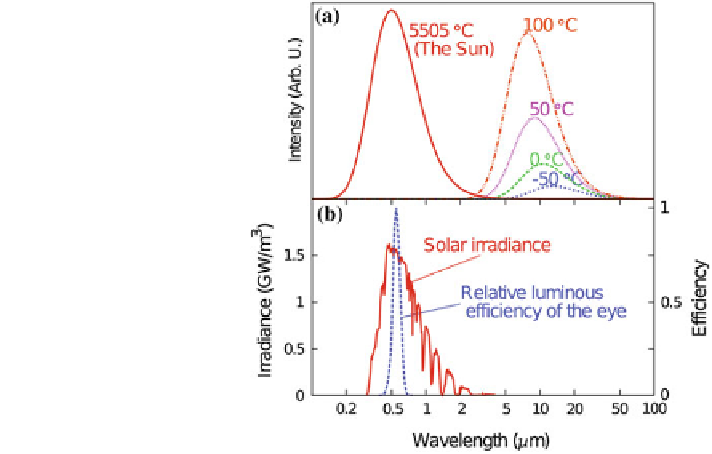Civil Engineering Reference
In-Depth Information
Fig. 1 Upper panel shows
blackbody spectra for several
temperatures, including that
of the sun's surface. Lower
panel illustrates a typical
solar irradiance spectrum at
ground level and during clear
weather, and the sensitivity of
the light-adapted human eye
the temperatures of interest, those between -50 and +100 C. Solar radiation, on
the other hand and also shown in the figure, comes at 0.3 \ k \ 3 lm, i.e., at
wavelengths that are shorter and almost non-overlapping with those for thermal
radiation. Solar irradiation at the earth's ground level almost corresponds to the
blackbody spectrum for the sun's surface temperature multiplied by the spectral
transmittance through the earth's atmosphere. The human eye, which is considered
next, only responds to part of the solar spectrum and has a bell-shaped sensitivity
curve at 0.4 \ k \ 0.7 lm with a peak at 0.55 lm, as again illustrated in Fig.
1
.
Quantitative measures of luminous and solar transmittance of a surface, denoted
T
lum
and T
sol
, can be obtained by averaging according to
T
lum
;
sol
¼
Z
dku
lum
;
sol
ð
k
Þ
T
ð
k
Þ =
Z
dku
lum
;
sol
ð
k
Þ ;
ð
1
Þ
where T(k) is spectral transmittance, u
lum
is the eye's sensitivity (Wyszecki and
Stiles
2000
), and u
sol
is solar irradiance for air mass 1.5 (with the sun at 37 above
the horizon) (ASTM
2008
).
The data in Fig.
1
indicate that the ''natural'' radiation is spectrally selective,
and it follows that surfaces devised to make the most of this radiation should be
spectrally selective too. For example, it may be desirable to have completely
different optical properties for solar and thermal radiation, and one can also create
surfaces which are very different for visible light and near-infrared solar irradiation
in the 0.7 \ k \ 3 lm range (Granqvist
1981
,
2007
; Smith and Granqvist
2010
).
Solar radiation can also be dominated by incidence from a specific direction, while
visual indoors-outdoors contact is largely along horizontal lines of sight, so
angular selective optical properties may be interesting. Finally, everyone knows
that the ''natural'' radiation is time variable and usually different during different

